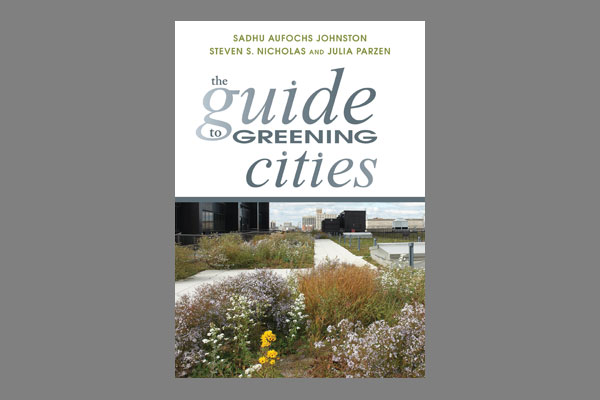
Authors: Sadhu Aufochs Johnston, Steven S. Nicholas and Julia Parzen (Island Press, 2013)
More and more books are focusing on how to effectively “green” our cities, or in other words, how to make them more sustainable for the future. Although each account I have read has taken a widely different approach to the subject, all have preached similar messages. I would include The Guide to Greening Cities to the latter, however, it stands in a category of its own in the sheer vastness of data collected within. Page after page was rife with excellent information on different elements integral to the greening of cities. In doing so, it attempted to describe the city as a whole dominantly through raw data. This was both its strength and weakness.
The book is broken into six chapters all pertaining to a different aspect of civic planning with sustainability. Throughout, The Guide to Greening Cities looks aggressively at government and their role in change. While this is a common theme among many books, I have yet to read one that goes into such detail about “Green City Leaders,” managers of sustainability growth and production in the city. Each chapter also had two sections following it called Case in Point and each was a case study based on something that was spoken about earlier in the chapter, to give further detail and information.
Although the above structure was very clear and simple, the data-focused content made it challenging for the content to flow as well as it could have. And while statistical modeling and scientific sampling tend to pique the interest of professionals in the field, it is often less appealing to the masses at large, who arguably should be the target audience for a solid book like this. This is reflective of the larger challenge of how to get people to pay attention to climate change that is plaguing the community of sustainability champions, as a whole.
With this in mind, The Guide to Greening Cities includes countless tables and graphs which make up heavy parts of the book. This information is meticulous in nature and is powerful in its ability to prove a point, be it a financial, ecological etc. The problem with this tactic is that while elements such as these are invaluable, the book walks a fine line between being a book for “the everyman” and a more restrictive text, meant for professionals who need the data for future study or precedent.
Because of this delicate balance, certain parts of the book may feel inaccessible for some individuals, and based on growing expert consensus, more and more people have trouble believing in climate change when they feel they can’t grasp a concept or understand a theory. This has been proven to not happen out of ignorance, but that even in some of the most educated, a blindness occurs when we are over-saturated with data without context. This is something that tends to happen a bit too often with the expertly crafted tables and graphs of The Guide to Greening Cities.
That being said, I cannot hold this against The Guide to Greening Cities as a book. At a time when experts in the field are desperately trying to make their message resonate with readers, it does exactly what is sets out to do – collecting and presenting important stats, facts, and figures on just how much change can occur through different policies and procedures. Its only flaw, is that it has been presented at a confusing time in our world, when great data can get lost in the shuffle of recognition.
The Guide to Greening Cities is definitely worth a read, but in order to really digest the content and do it justice, give yourself time to calculate through the authors’ magnificent amount of findings, and be prepared to truly invest yourself in the wonderful multitude of data presented.
***
For more information on The Guide to Greening Cities check out the Island Press website. Also, be sure to visit the companion website.
**
Jeremy Senko is happily lost in the world of theoretical architecture and design. He is forever a student at heart, consistently reading, experiencing and learning about the world he inhabits. More specifically, he recently completed his Bachelor of Interior Design at Kwantlen Polytechnic University, where he pushed the limits (and the patience) of his professors.



One comment
You can borrow a copy from the North York Central Library or have a look at the book at the Toronto Reference Library, Humanities and Social Sciences Dept., 2nd floor. Call number: 307.1416 JOH